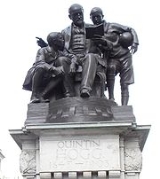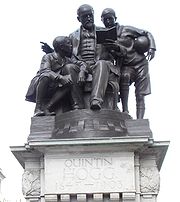
Quintin Hogg
Encyclopedia
- For the cabinet minister, see Quintin Hogg, Baron Hailsham of St MaryleboneQuintin Hogg, Baron Hailsham of St MaryleboneFor the businessman and philanthropist, see Quintin Hogg Quintin McGarel Hogg, Baron Hailsham of St Marylebone, KG, CH, PC, QC, FRS , formerly 2nd Viscount Hailsham , was a British politician who was known for the longevity of his career, the vigour with which he campaigned for the Conservative...
Quintin Hogg (14 February 1845 – 17 January 1903) was an English
England
England is a country that is part of the United Kingdom. It shares land borders with Scotland to the north and Wales to the west; the Irish Sea is to the north west, the Celtic Sea to the south west, with the North Sea to the east and the English Channel to the south separating it from continental...
philanthropist
Philanthropist
A philanthropist is someone who engages in philanthropy; that is, someone who donates his or her time, money, and/or reputation to charitable causes...
, remembered primarily as a benefactor of the Royal Polytechnic institution at Regent Street, London now known as the University of Westminster
University of Westminster
The University of Westminster is a public research university located in London, United Kingdom. Its origins go back to the foundation of the Royal Polytechnic Institution in 1838, and it was awarded university status in 1992.The university's headquarters and original campus are based on Regent...
.
Early life
Hogg, the seventh son of Sir James Hogg, 1st Baronet, was born and spent most of his life in LondonLondon
London is the capital city of :England and the :United Kingdom, the largest metropolitan area in the United Kingdom, and the largest urban zone in the European Union by most measures. Located on the River Thames, London has been a major settlement for two millennia, its history going back to its...
. He was educated at Eton College
Eton College
Eton College, often referred to simply as Eton, is a British independent school for boys aged 13 to 18. It was founded in 1440 by King Henry VI as "The King's College of Our Lady of Eton besides Wyndsor"....
, where he was known as "Piggy Hogg". Hogg was an accomplished sportsman and along with many Etonians he was a pioneer of Association Football. Whilst at Eton, he won the Eton Fives
Eton Fives
Eton Fives, one derivative of the British game of Fives, is a hand-ball game, similar to Rugby Fives, played as doubles in a three-sided court. The object is to force the other team to fail to hit the ball 'up' off the front wall, using any variety of wall or ledge combinations as long as the ball...
, was keeper of fives and in the shooting XI, as well as being a member of the Wall and Field football XIs. He showed strong religious convictions and held prayer meetings; he was also a prominent rifle volunteer.
He made 31 appearances for Wanderers F.C.
Wanderers F.C.
Wanderers Football Club is an English amateur football club, based in London, that plays in the Surrey South Eastern Combination. Founded as Forest Football Club in 1859, the club changed its name to Wanderers in 1864....
(winners of the first F.A. Cup) between the 1865–66 and the 1870–71 seasons. He twice represented Scotland versus England in the unofficial internationals of 1870 and 1871. He captained the Old Etonians
Old Etonians F.C.
The Old Etonians Football Club is an English football club whose players are taken from previous attendees of Eton College, in Eton, Berkshire.-History:...
for seven years, during which he was never on the losing side.
He became involved in trade, particularly the commodities of tea
Tea
Tea is an aromatic beverage prepared by adding cured leaves of the Camellia sinensis plant to hot water. The term also refers to the plant itself. After water, tea is the most widely consumed beverage in the world...
and sugar
Sugar
Sugar is a class of edible crystalline carbohydrates, mainly sucrose, lactose, and fructose, characterized by a sweet flavor.Sucrose in its refined form primarily comes from sugar cane and sugar beet...
. As a senior partner in a firm of tea merchants, he modernized sugar production in Demerara
Demerara
Demerara was a region in South America in what is now Guyana that was colonised by the Dutch in 1611. The British invaded and captured the area in 1796...
. While in Demerara he played two first-class cricket
First-class cricket
First-class cricket is a class of cricket that consists of matches of three or more days' scheduled duration, that are between two sides of eleven players and are officially adjudged first-class by virtue of the standard of the competing teams...
matches for the colony.
Educational reform
Having made his fortune, he became concerned with Christian-motivated philanthropy. London at the time suffered from social conditions now summarised in the single word "Dickensian". Hogg turned his energy to educational reform: in 1864 he founded York Place Ragged SchoolRagged school
Ragged Schools were charitable schools dedicated to the free education of destitute children in 19th century England. The schools were developed in working class districts of the rapidly expanding industrial towns...
. With Arthur Fitzgerald Kinnaird (1847–1923, later 11th Baron Kinnaird) and Thomas Henry William Pelham (1847–1916), he rented rooms in York Place (formerly Of Alley), off The Strand
Strand, London
Strand is a street in the City of Westminster, London, England. The street is just over three-quarters of a mile long. It currently starts at Trafalgar Square and runs east to join Fleet Street at Temple Bar, which marks the boundary of the City of London at this point, though its historical length...
in central London
Central London
Central London is the innermost part of London, England. There is no official or commonly accepted definition of its area, but its characteristics are understood to include a high density built environment, high land values, an elevated daytime population and a concentration of regionally,...
, for a boys' school, initially a day school, which subsequently began to open in the evenings. In 1882, he founded the Young Men's Christian Institute, which was renamed the Regent Street Polytechnic (incorporating the Royal Polytechnic Institution). Regent Street Polytechnic was later part of London Polytechnic and is now the University of Westminster
University of Westminster
The University of Westminster is a public research university located in London, United Kingdom. Its origins go back to the foundation of the Royal Polytechnic Institution in 1838, and it was awarded university status in 1992.The university's headquarters and original campus are based on Regent...
. It is the largest provider of adult education
Adult education
Adult education is the practice of teaching and educating adults. Adult education takes place in the workplace, through 'extension' school or 'school of continuing education' . Other learning places include folk high schools, community colleges, and lifelong learning centers...
in London, and its headquarters are still at the same location on Regent Street
Regent Street
Regent Street is one of the major shopping streets in London's West End, well known to tourists and Londoners alike, and famous for its Christmas illuminations...
.

Other
Quintin Hogg also served as alderman of the first London County CouncilLondon County Council
London County Council was the principal local government body for the County of London, throughout its 1889–1965 existence, and the first London-wide general municipal authority to be directly elected. It covered the area today known as Inner London and was replaced by the Greater London Council...
, encouraging the founding of other polytechnics
Polytechnic (United Kingdom)
A polytechnic was a type of tertiary education teaching institution in England, Wales, and Northern Ireland. After the passage of the Further and Higher Education Act 1992 they became universities which meant they could award their own degrees. The comparable institutions in Scotland were...
, or, as they were known then, working men's (or mechanics') institutes.
He married Alice Anna Graham, daughter of William Graham, on 16 May 1871 in the St George Hanover Square
Hanover Square, London
Hanover Square, London, is a square in Mayfair, London W1, England, situated to the south west of Oxford Circus, the major junction where Oxford Street meets Regent Street....
area. They had three sons and two daughters:
- Douglas Hogg, 1st Viscount HailshamDouglas Hogg, 1st Viscount HailshamDouglas McGarel Hogg, 1st Viscount Hailsham PC was a British lawyer and Conservative politician.-Background:...
(1872–1950) - Elsie Florence Hogg (1873- ? ), married Vincent Robertson Hoare (1873-1915)
- Ian Graham Hogg (1875–1914), lieutenant colonel, died September 1914 of wounds.
- Ethel Mary Hogg (1876–1970), married Herbert Frederick Wood. She wrote a biography of her father as Ethel M. Wood;
- Malcolm Nicholson Hogg (1883–1948)
Hogg was the grandfather of Quintin Hogg, Baron Hailsham of St Marylebone
Quintin Hogg, Baron Hailsham of St Marylebone
For the businessman and philanthropist, see Quintin Hogg Quintin McGarel Hogg, Baron Hailsham of St Marylebone, KG, CH, PC, QC, FRS , formerly 2nd Viscount Hailsham , was a British politician who was known for the longevity of his career, the vigour with which he campaigned for the Conservative...
.
He died in 1903.
Aside from the university, Hogg is commemorated by a Caribbean
Caribbean
The Caribbean is a crescent-shaped group of islands more than 2,000 miles long separating the Gulf of Mexico and the Caribbean Sea, to the west and south, from the Atlantic Ocean, to the east and north...
island (Hogg Island in Guyana
Guyana
Guyana , officially the Co-operative Republic of Guyana, previously the colony of British Guiana, is a sovereign state on the northern coast of South America that is culturally part of the Anglophone Caribbean. Guyana was a former colony of the Dutch and of the British...
), a sports team (Middlesex league QUINTIN Rugby Football Club), the statue depicted above, and a Blue Plaque
Blue plaque
A blue plaque is a permanent sign installed in a public place to commemorate a link between that location and a famous person or event, serving as a historical marker....
on the house he occupied for many years, which abuts the university but faces onto Cavendish Square
Cavendish Square
Cavendish Square is a public square in the West End of London, very close to Oxford Circus, where the two main shopping thoroughfares of Oxford Street and Regent Street meet. It is located at the eastern end of Wigmore Street, which connects it to Portman Square, part of the Portman Estate, to its...
.
Principal source
- G. S. Woods, "Hogg, Quintin (1845–1903)", rev. Roger T. Stearn, Oxford Dictionary of National Biography, Oxford University Press, 2004; online edn, May 2010; accessed 11 March 2011 (subscription required for the convenience link). Material not otherwise credited will be found here.

